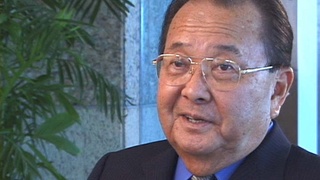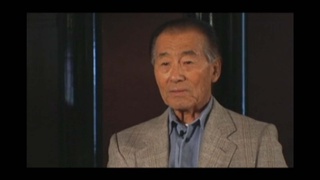Entrevistas
Tanforan Assembly Center
I remember that morning. We all assembled. Half a block from the house. It was a big crowd, and there was a line of buses on Bush Street. And they had soldiers. Military guards. And of course, at that age, my image of them, they were like monsters. Great big guys. And most of the nihonjins were all pretty much, much smaller. So the soldiers looked huge to me. And then we were given tags. I remember, it was kind of cold, drizzly, San Francisco weather. And then we, with our name tags, we boarded the buses. And as the buses pulled out, you look out the window and you see more of the Issei and Nisei, accumulating for the next bus, and they had the luggage and stuff all piled up.
Then it was, I can’t really remember the time of it. But the next thing you know, we were pulling up to Tanforan. I’ve never been there before because, you know, being a kid. A race track. And then we got off, and I remember seeing the grand stand. And then all these horse stables. But on the inner part of the, I guess you might say, Tanforan. The barracks were being built. But they were all pretty new.
We were one of the lucky ones that actually had a new barrack. But some of my earlier friends that went there, they were staying in the horse stables. I remember them saying that, when they arrived, the stench of the manure, from the horses, was just just terrible. And then, of course, they had horse flies flying around, and in the corner big cobwebs, you know.
And then, they had these army cots folded, kind of laying on the side there. So they would unfold the cots, and “Where’s the mattress?” They said, “See those sacks? You go out and there’s stacks of hay. So you just fill those sacks and that’s your mattress.” Can you imagine if you’re allergic or have allergies, to have to sleep on that. As well as the stench and the thing.
Data: August 26, 2015
Localização Geográfica: California, US
Entrevistado: John Esaki
País: Watase Media Arts Center, Japanese American National Museum
Explore More Videos

O governo incentivou nipo-canadenses a partirem para o Japão (Inglês)
(n. 1928) Médico. Ex-Chairman da Fundação pelas Reparações aos Nipo-Canadenses





Loyalty questionnaire
(1916-2010) Resistiu ao alistamento militar, ajudou a formar o Comitê Heart Mountain Fair Play

Speaking out in camp
(1916-2010) Resistiu ao alistamento militar, ajudou a formar o Comitê Heart Mountain Fair Play

Resistindo à transferência de Jerome (Inglês)
(1919 - 2006) Veterano da Segunda Guerra Mundial e da Guerra da Coréia

Draft resisters sent to jail
(1916-2010) Resistiu ao alistamento militar, ajudou a formar o Comitê Heart Mountain Fair Play

Aparência versus Eficácia de Combate (Inglês)
(1919 - 2006) Veterano da Segunda Guerra Mundial e da Guerra da Coréia

Would do the same again
(1916-2010) Resistiu ao alistamento militar, ajudou a formar o Comitê Heart Mountain Fair Play

Treinamento Básico (Inglês)
(1919 - 2006) Veterano da Segunda Guerra Mundial e da Guerra da Coréia

Uma visita ao Jerome após OCS (Inglês)
(1919 - 2006) Veterano da Segunda Guerra Mundial e da Guerra da Coréia

Faça isso por todos os asiáticos (Inglês)
(1919 - 2006) Veterano da Segunda Guerra Mundial e da Guerra da Coréia

Imagens horríveis da guerra (Inglês)
(1919 - 2006) Veterano da Segunda Guerra Mundial e da Guerra da Coréia
